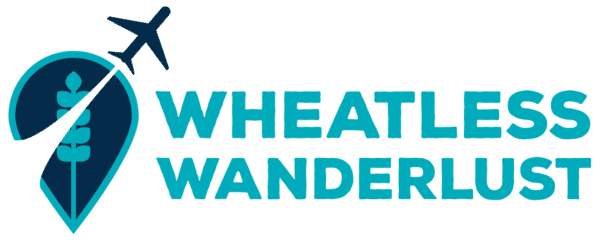Exactly Where to Stay in Banff (for First Timers)
Banff is one of Canada’s most iconic National Parks, if not THE most iconic. While it is a popular winter sports destination, in our opinion, summer is when Banff is at its best.
We’ve been to Banff twice over the past several years (we LOVE the Canadian Rockies!), spending more than a week in and around Banff on each of those trips.
The whole area is an outdoor lover’s paradise, filled with countless hiking and cycling trails, some of the prettiest scenery you will ever see, like Insta-famous Moraine Lake, and some fantastic wildlife spotting opportunities.
If you’re like most people, you only have a short time in Banff, so the question of where to stay is an important one to make the most of your limited time.
In this guide, we’re going to use our experiences exploring Banff to walk you through all the information you need to figure out where to stay in Banff for your particular style, budget, and preferences.
We’re going to cover three areas that we think would make an excellent home base for your trip.
For each, we’ll give you our experience with the area, a list of pros and cons of staying in each area, and some cool places to stay.
Our intention is that, by the end of it all, you’ll have the information you need to choose the perfect place to stay in Banff based on your particular style, budget, and preferences.
Sound good to you? Let’s get into it.
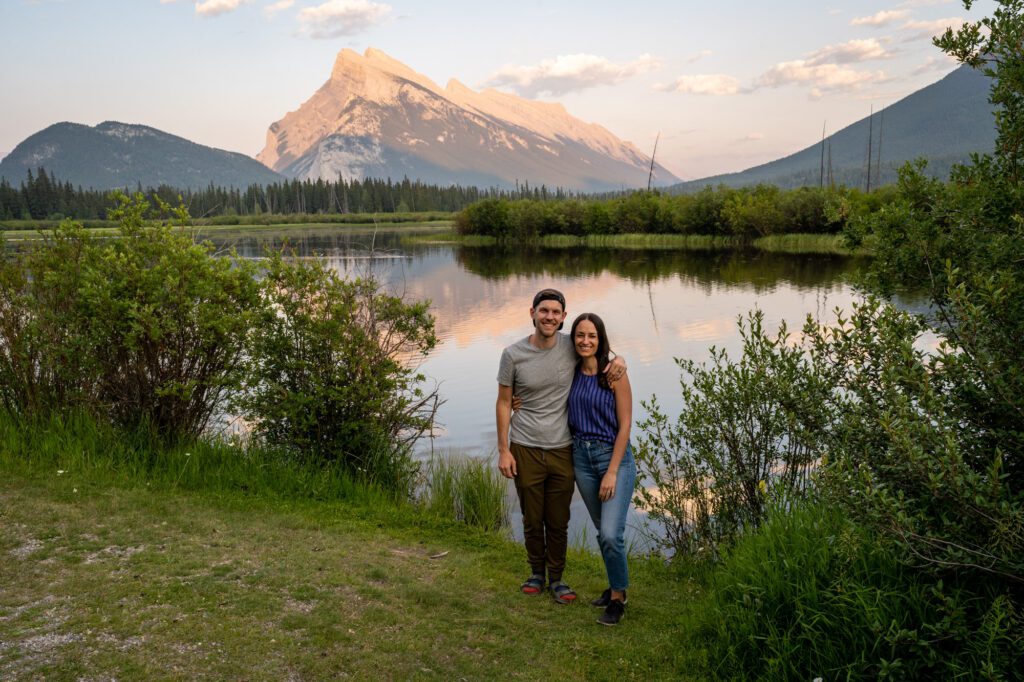
Disclaimer: Some of the links in this post, like hotel links, are affiliate links, meaning at no additional cost to you, we make a little bit of money if you click through and book. That being said, we would never recommend something to you that we don’t stand behind 100%.
A Quick Geography Overview of Banff
If you happen to have already read our Banff itinerary (or our full Canadian Rockies itinerary), then you’ll know that we are strong proponents of splitting your stay in Banff in two, and spending half of it in either Banff or Canmore (more on the differences between the two below), and the other half around Lake Louise.
The reason?
It’s a 45-60 minute drive from the town of Banff to Lake Louise, and the parking situation in Lake Louise is a nightmare.
If you want to park at the lot at Lake Louise, you’ll need you to arrive at an ungodly hour (6:30am in the height of summer) to have the privilege of paying $21 to park for the day and get an early start on the trail.
Lake Louise is one of the most iconic sights in Banff National Park – all of Canada, we’d say – and as a result, it is incredibly popular and crowded basically all day long, with the notable exception of around sunrise.
By staying nearby, you’ll be able to beat the crowds (a 7 minute drive versus a 45 minute drive), snap some amazing pictures, and get an early start on the trails.
We did this on our first trip to Banff (staying at Paradise Lodge and Bungalows, which is great) and it was amazing.
On our latest trip, we had a campsite booked at Lake Louise Campground. It was also great, pup antics notwithstanding, but we learned as we were going to bed that our dog, Lupine, was not a fan of being enclosed in a tent.
We ended up staying in Banff instead, and hated driving 45-60 minutes to the start of the Banff hikes that start near Lake Louise.
To maximize your time and minimize your driving back and forth, we’d recommend basing yourself near Lake Louise for a couple of nights (2-3 is enough for both Lake Louise and Moraine Lake).
Where to Stay in Banff: The Best Places to Stay for First Timers
Now that we’ve covered the overarching strategy for choosing a place to stay (using multiple home bases to minimize driving back and forth), let’s talk specifics.
We have stayed in all three places we’re talking about – Banff, Canmore, and Lake Louise – so we can provide some insight into the pros and cons and specific highlights we enjoyed based on our own trips to Banff.
Now, I can already tell that some of you are screaming at the computer screen something along the lines of “just get to the point and tell me where to stay,” so here’s a quick overview of the more in-depth guide below.
We’d recommend reading the full section you’re interested in, though, because you might discover a place or two you hadn’t found before!
Here’s the overview:
- The Town of Banff is the best place to stay for both short trips and first timers in Banff, because it is truly in the middle of all the action. Banff Avenue is packed with restaurants and shops (with Mount Rundle’s distinctive shape towering over town), and it’s about as central as you can get to most of the hikes and attractions in the eastern end of Banff National Park. We stayed at Tunnel Mountain Resort, and largely enjoyed it – especially because of the full kitchen and dog-friendliness – but would absolutely choose Basecamp Suites in the future after a great experience with Basecamp in Revelstoke.
- Canmore is a town just outside the eastern border of Banff National Park, and it is cooler with better food and drink options, more modern accommodations, and more affordable prices. However, the downside is that it’s an extra 15 minutes or so away from most of the attractions in Banff. For what it’s worth, we decided after our latest trip that we will always stay in Canmore in the future. We’d look at the Malcolm Hotel if you’re seeking something a little more upscale, or Lamphouse by Basecamp for something a little more affordable (but still nice).
- Staying in Lake Louise Village to beat the crowds to Lake Louise in the early morning is something we strongly recommend you do (more on why that is in the next section below). We’ve done it both ways – staying near Lake Louise (a 2-7 minute drive to the parking lot) and staying in Banff (a 45-60 minute drive to the parking lot) and cannot recommend spending a couple of nights near Lake Louise more highly. Bonus points for being walkable to the lake to avoid the nightmare that is parking! The best place to stay – and we’ve stayed here, so we can say that – is the Paradise Lodge and Bungalows, which is walkable to the lake and has a variety of room types available, including rooms with full kitchens.
Here’s a map so you can see visualize what we’re talking about in terms of locations and drive times.
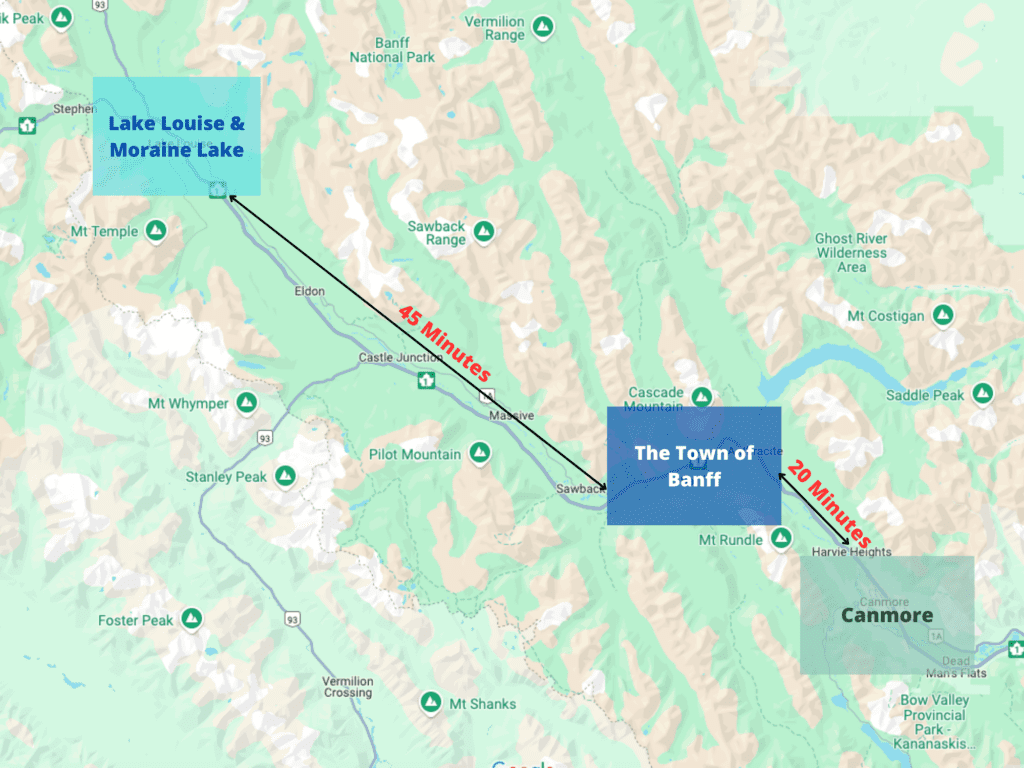
And now, on to our more detailed recommendations on where to stay.
The Town of Banff: In the Middle of All the Action
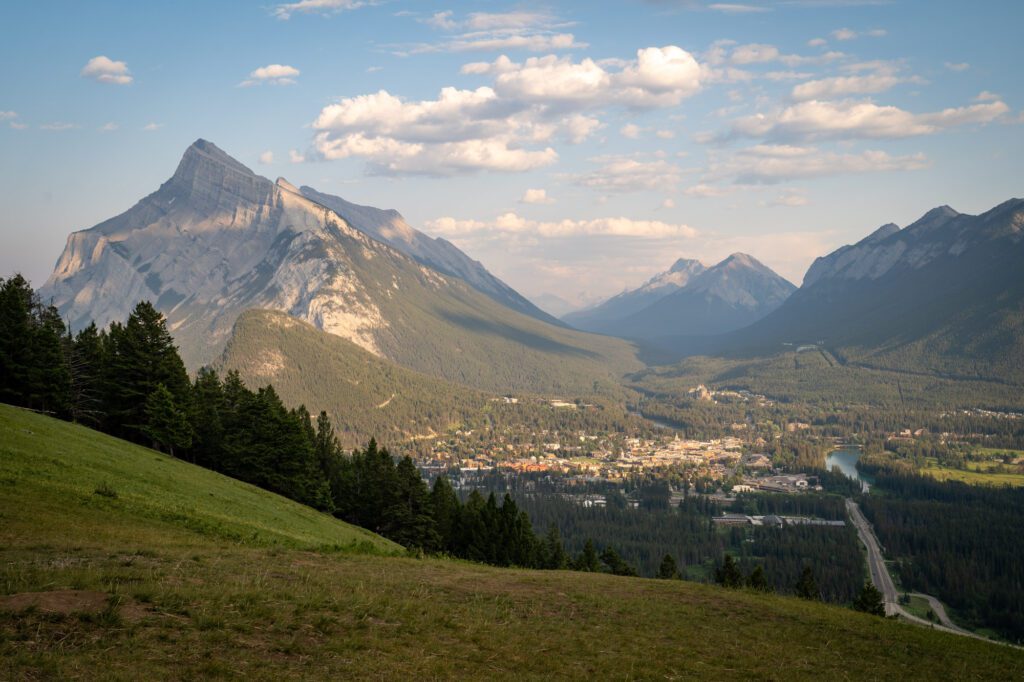
The first thing we need to say about the town of Banff is that it is essentially Disneyland.
But instead of being packed with families in Mickey ears, those same families have swapped the mouse ears for hiking boots and daypacks.
It suffers many of the same issues that other popular tourist areas, whether it’s a trendy neighborhood in a city (Fisherman’s Wharf in San Francisco) or a tourist town near a national park (Moab, Utah). That issue is twofold.
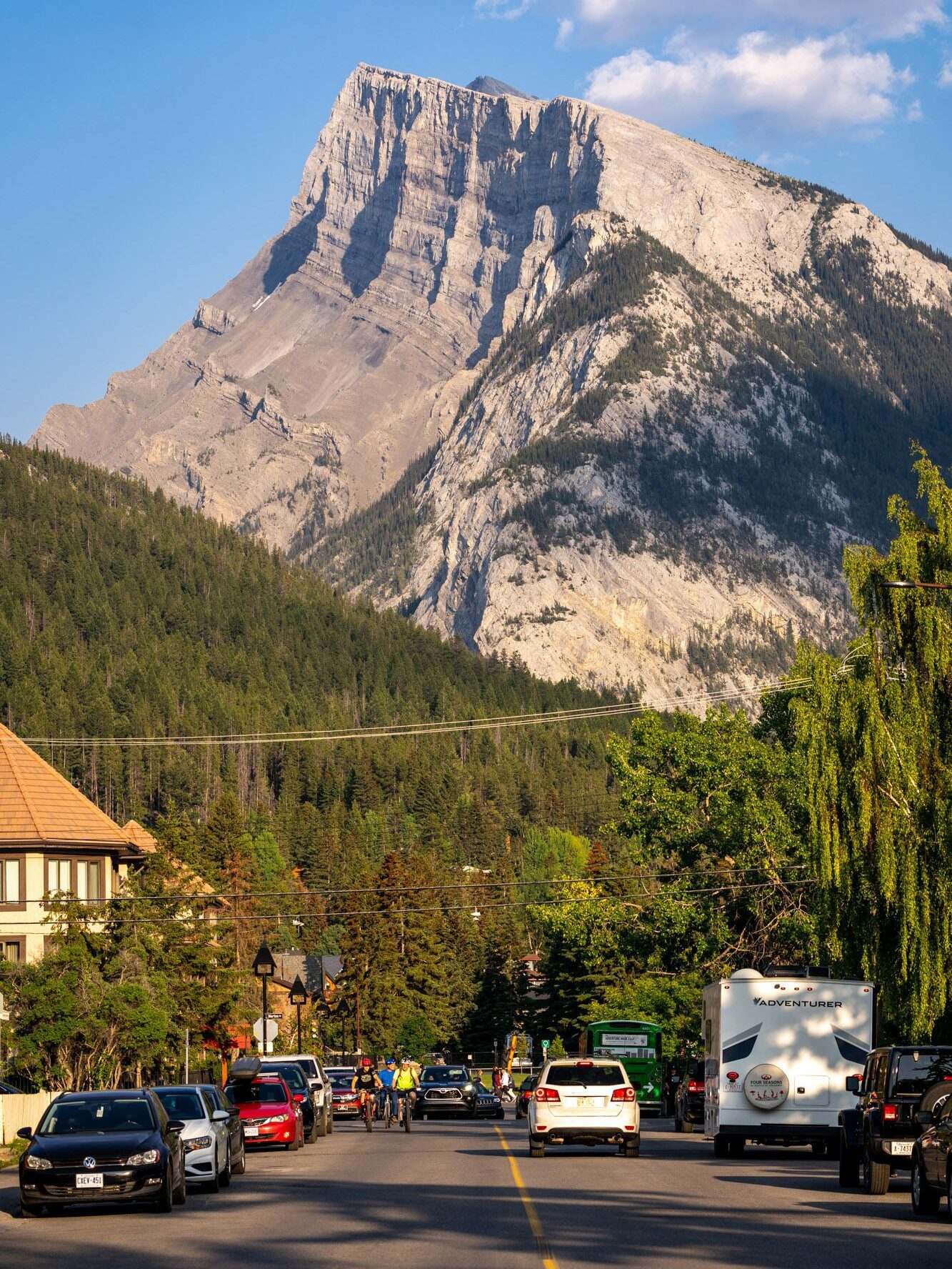
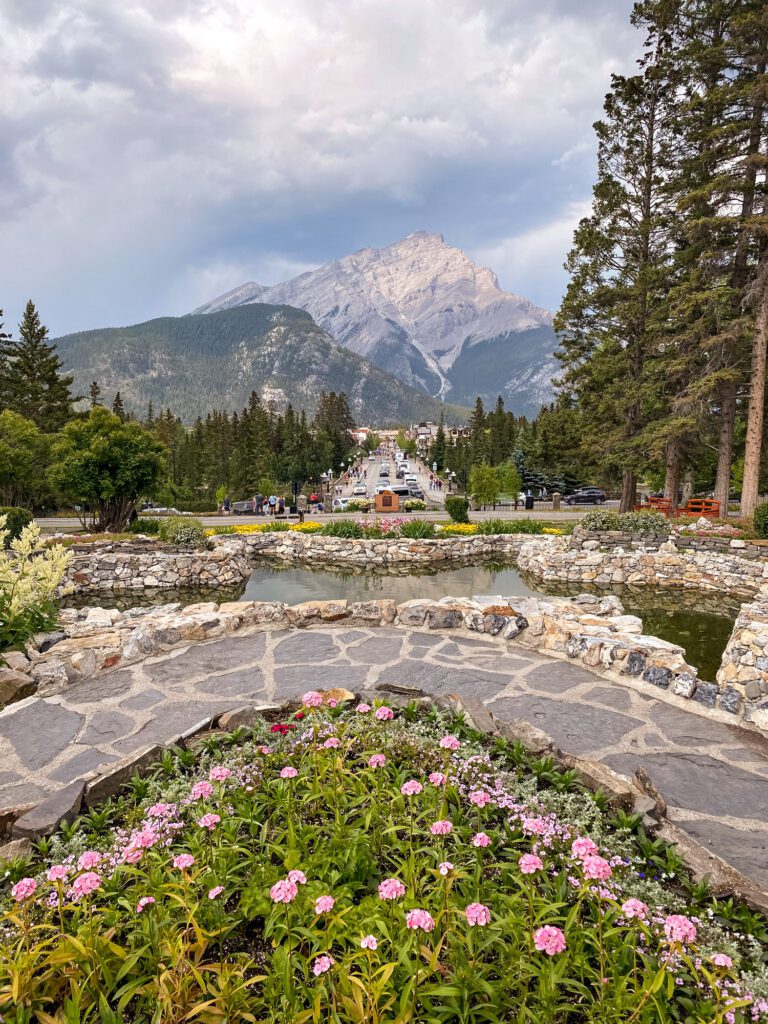
First, that all of the hotels, shops, bars, and restaurants are constantly at maximum capacity, so there’s no time or incentive to improve and renovate.
Second, it’s too expensive for new entrants to try and start a business, so there’s very little excitement in terms of innovation happening (go to Canmore for that).
It’s crowded, expensive, and the places to eat, drink, and shop are largely overrated and full of tourists.
Oh, and make sure your hotel or lodge includes parking, because it can be a nightmare to find a parking spot.
However, all that being said, it is probably the most convenient place to stay, ESPECIALLY if you’re not using our strategy of staying in two separate places in Banff.
It’s right in the middle of all the action, with Lake Minnewanka, Sunshine Meadows, and the Bow Valley Parkway all within 15-30 minutes.
Banff Avenue runs straight through the middle of town, and most hotels in Banff are either right on that drag, or a few blocks off of it in either direction.
There’s also a collection of places to stay – including an affordable hostel option – up on Tunnel Mountain.
In short, Banff makes for a good home base, though it’s crowded and expensive, like any mountain town this close to world-class outdoor recreation these days.
Pros and Cons of Staying in Banff
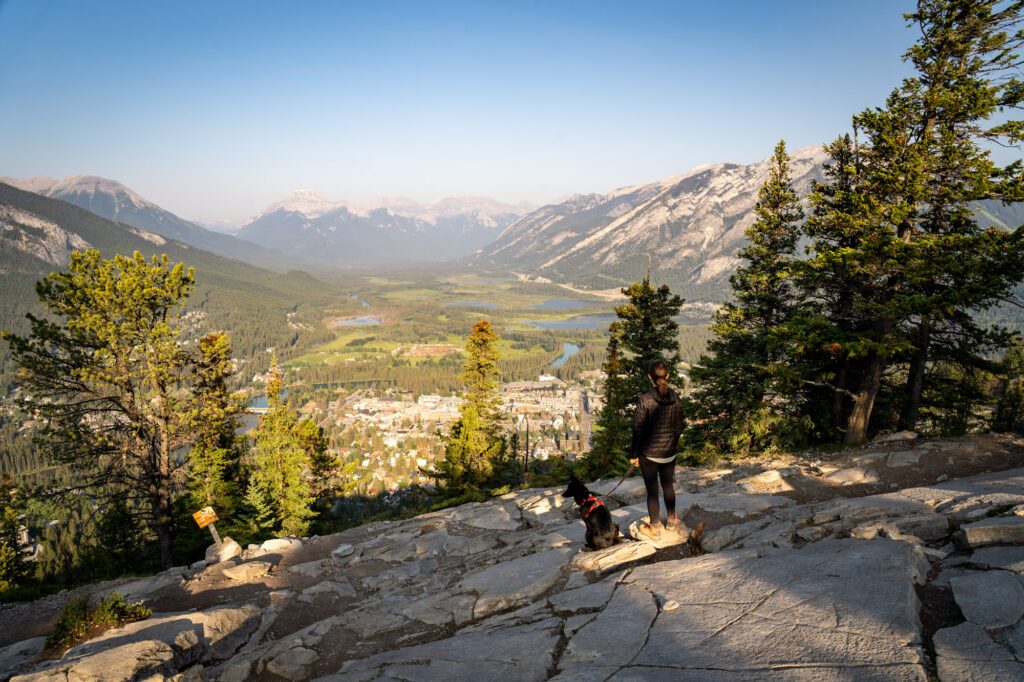
Pros of Staying in Banff:
- It’s central. This is the main reason why we recommend Banff. Within 15-30 minutes, you can be just about anywhere east of Lake Louise, including Johnston Canyon, Sunshine Meadows, Canmore, and Lake Minnewanka.
- It has nice amenities (groceries, gas, food and drink, etc). They’re busy, but there are a lot of options when it comes to eating and drinking, and several gas stations to choose from. The IGA in Banff is nice, too, for groceries. Though, we’d argue, the amenities aren’t quite as nice as Canmore (but way nicer than Lake Louise).
- Public transit connections are surprisingly good. This is kind of unexpected for a mountain town in a national park, but there are buses running from downtown Banff to Johnston Canyon, Lake Louise, Moraine Lake (at some points in the year), Lake Minnewanka, and Canmore, to name a few. Check ROAM Transit for details.
Cons of Staying in Banff:
- It’s expensive. All of these places are going to be expensive, but the town of Banff itself might just be the king of pricey accommodations.
- Most places are relatively old and need some TLC. It reminds us of national park lodges in the US, which are constantly at capacity and never have time for remodels or renovations. Some of the accommodation options here are a bit…dated.
- Parking can be tough (or expensive). If your hotel doesn’t have free parking, be prepared to either pay for parking at the hotel, or deal with the parking situation in town (which is not as bad as we thought it would be, but still not good).
The Best Places to Stay in the Town of Banff
There are a nearly unlimited number of places to stay in the town of Banff itself.
Here are seven that stand out to us, whether it’s because they look nice and we’d like to stay there, or because they serve some other purpose (usually related to budget).
Similar to Lake Louise below, we’re going to go ahead and skip including the Fairmont Banff Springs Hotel, which is gorgeous, but is just not worth the incredibly high price.
It’s not like the rest of Banff is going to be cheap to stay in, but the prices at the Fairmont seem excessive.
Moose Hotel & Suites: Beautiful Hotel in Downtown Banff
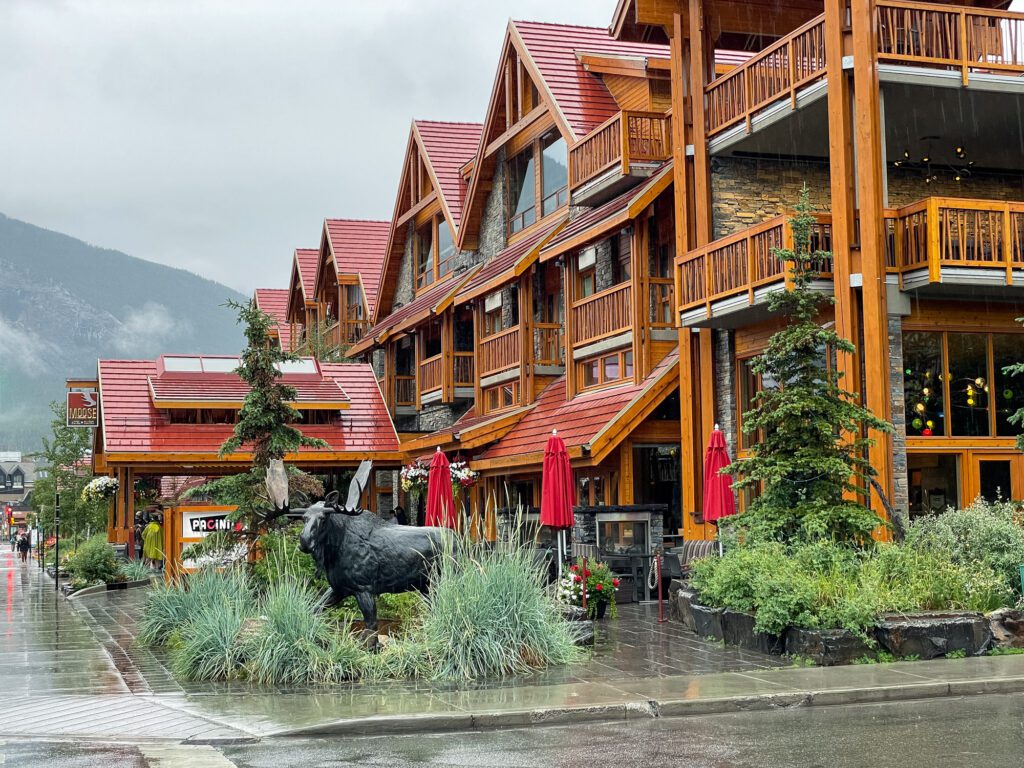
We’ve driven or walked by the Moose Hotel and Suites countless times at this point (our favorite coffee shop in Banff is right across the street), and we’re always drawn to the huge moose statue on the corner outside the lobby.
In terms of location, it’s on the corner of Banff Avenue, but it’s a few blocks removed from the main stretch, so it’s going to be at least a little bit quieter.
The vibe here definitely skews more towards luxury hotel than budget-friendly, but the amenities pack a punch. Rooms come in two basic types – hotel-style rooms, and bigger suites with more space (like sitting areas and small balconies). Plus, cool two-way fireplaces that heat the rooms in the winter.
However, it is worth noting that those bigger suites DO NOT come with full kitchens, which we see as a major bummer.
The hotel has a fitness center, a big indoor pool, and TWO outdoor hot pools on the rooftop with excellent views out over Banff. That rooftop also has some nice firepit action going on.
They also give you a free pass to use on Roam Transit, Banff’s public transportation company, which has local service as well as service to Lake Louise, Lake Minnewanka, Canmore, and more.
It’s well worth considering using public transportation to avoid the congestion and parking nightmare in some of those places.
Pet friendly? Some rooms here are pet friendly, with a $25 pet fee per pet, per night. You need to let them know in advance, and they’ll provide treats, a water bowl, and a blanket on arrival.
What’s the parking situation? Parking is free in a secure underground garage, but the clearance is 6’7”, which means vans, RVs, and even some vehicles with roof boxes will need to park offsite (they have a different location for that).
Basecamp Banff Suites: Nice Suites (with Kitchens) in the Middle of All the Action
We’ve said this many, many times at this point across all of our Canadian Rockies guides, but we love Bascamp.
We stayed at their Revelstoke resort, and we slept like babies in the comfy beds and used the modern kitchen to cook our meals.
They’re based in the Canadian Rockies, and have a bunch of properties spread across Banff and Canmore with more on the way.
Their “suite” hotels are where it’s at for us, because we like to have access to a kitchen when we’re traveling to make sure Matt, who has Celiac Disease and needs to eat strictly gluten free, can eat safely on the road.
They’re basically a hotel, where the rooms are apartments (aka an aparthotel, which is our favorite type of place to stay when we’re traveling for the amenities of an apartment and the service of a hotel).
Their property in Banff – Basecamp Banff Suites – is one block off of Banff Avenue, and is right around the corner from the best grocery store in Banff (IGA Banff).
They have a mix of one, two, and three bedroom apartments that accommodate a nice range of group sizes. All have full kitchens and other modern amenities, like coffee makers and comfortable beds.
Pet friendly? This Basecamp location is NOT pet friendly (otherwise we probably would have stayed here on our last trip, when Lupine was with us).
What’s the parking situation? This location also DOES NOT have free parking. It’s either street parking (you park for free on the street if you’re willing to walk 5-7 minutes there and back) or a nearby garage for $30 a day with no in/out privileges.
Tunnel Mountain Resort (Where We Stayed): A Mid Range Resort Option on Tunnel Mountain
Tunnel Mountain Resort is where we stayed on our latest trip to Banff, and it’s kind of a mixed bag in terms of whether we’d recommend it or not.
We had two specific needs – pet friendly rooms with a full kitchen so we could cook – and this place met both of them.
The room was fine, but it was essentially a basement apartment with very little natural light, and we had a mouse friend visit us a few times. After telling the front desk about the mouse, they basically shrugged and said “there’s nothing we can do.” The facilities could also use a little bit of TLC and a refresh.
The location is nice because it’s relatively quiet up on Tunnel Mountain (that’s putting aside our drunk upstairs neighbors coming back from a wedding and blasting music at 3am) and parking is easy in the lot at the hotel.
They also give you free transit passes to jump on the bus that stops right outside the front door and whisks you away to downtown Banff in 5-10 minutes.
Overall? Fine, especially for the price, but you can also probably do better in Banff (or Canmore).
Pet friendly? Yes, but only certain rooms and they come with a $25 per night pet fee.
What’s the parking situation? Free parking in the onsite lot.
The Dorothy Motel: An Affordable Option in Banff
At the Dorothy Motel, they’ve basically taken an old motel, kept the frame intact, and renovated the inside to make it look and feel significantly more modern.
The prices here are pretty reasonable for Banff, and it probably punches above its weight in terms of value.
Rooms here are straightforward. Choose between one king bed or two queen beds, all of which have a mini fridge, microwave, and tea and coffee.
The location is a little further out than some of the other options that are within a few blocks of all the action, but it’s still on Banff Avenue, just further east out of town a bit.
This place is owned by Banff Lodging Company, which owns many of the hotels and lodges in Banff at this point after consolidation in the low period between 2020 and now. They own, among other places, Tunnel Mountain Resort, where we stayed.
Pet friendly? Yes, with a $25 a night pet fee.
What’s the parking situation? Free parking in the onsite lot.
HI Banff Alpine Centre: Solid Hostel on Tunnel Mountain
If you’re looking for the best place to stay in Banff on a budget, this is it. The HI Banff Alpine Center is run by Hostelling International (hence the HI) and is up on Tunnel Mountain, a short bus ride away from the action.
It is a hostel, so they have a mix of bunk rooms – including rooms that are women only – for those on a super tight budget, and private rooms with either an ensuite bathroom, or a shared bathroom. Shared facilities included a shared kitchen, laundry, and free parking.
There’s an onsite restaurant and an onsite bar with a packed calendar of events, and your stay includes a transit pass that will allow you to hop on the bus that stops across the street to get down to Banff Avenue and access all the places to eat and drink there.
Two Jack Lake Campground: The Best Campground near the Town of Banff
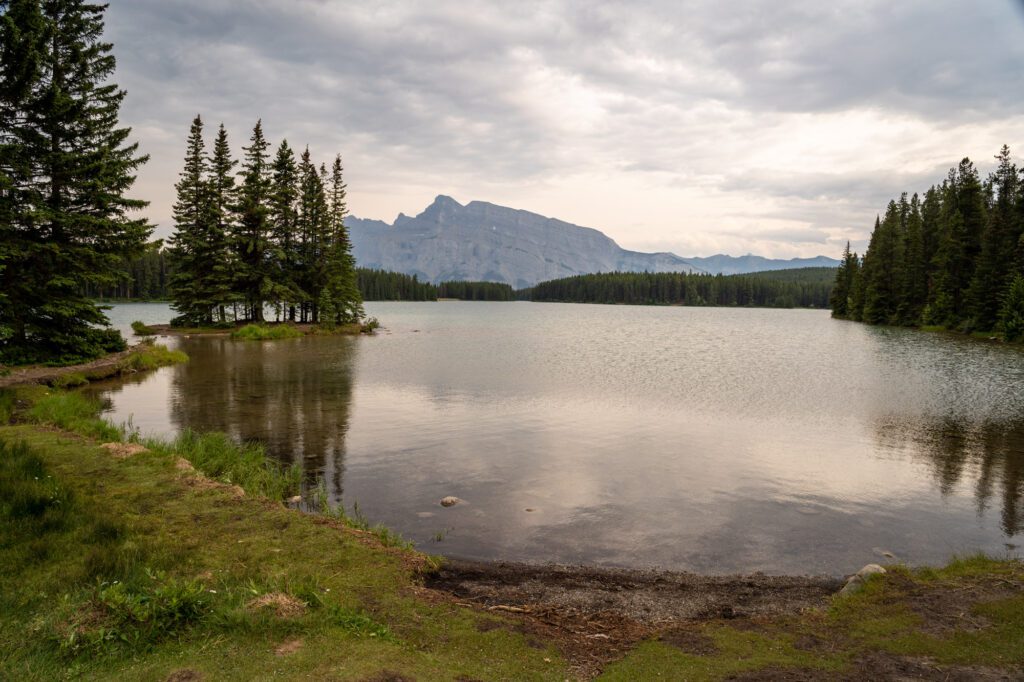
If you’re looking to camp near Banff, we would head straight for the campground at Two Jack Lake (rather than the campground up on Tunnel Mountain, which is bigger but far less fun because it’s not on a lake).
The real winner is Two Jack Lakeside Campground (there are two campgrounds here – “Main” and “Lakeside). There are 74 sites, some of which are right on the lake, and this campground has showers.
Two Jack Main is the bigger of the two campgrounds near the lake, and it has 300+ sites so it’s easier to secure a few summer nights here. No showers at this campground.
However, if you’re traveling in an RV bigger than 27 feet, you probably would want to book the Tunnel Mountain campground instead, which has far more RV spots with hookups (though it is essentially just a big parking lot, which kind of sucks).
More information on camping in Banff National Park here.
Canmore: A Cooler Town & Better Value, But Slightly Less Convenient
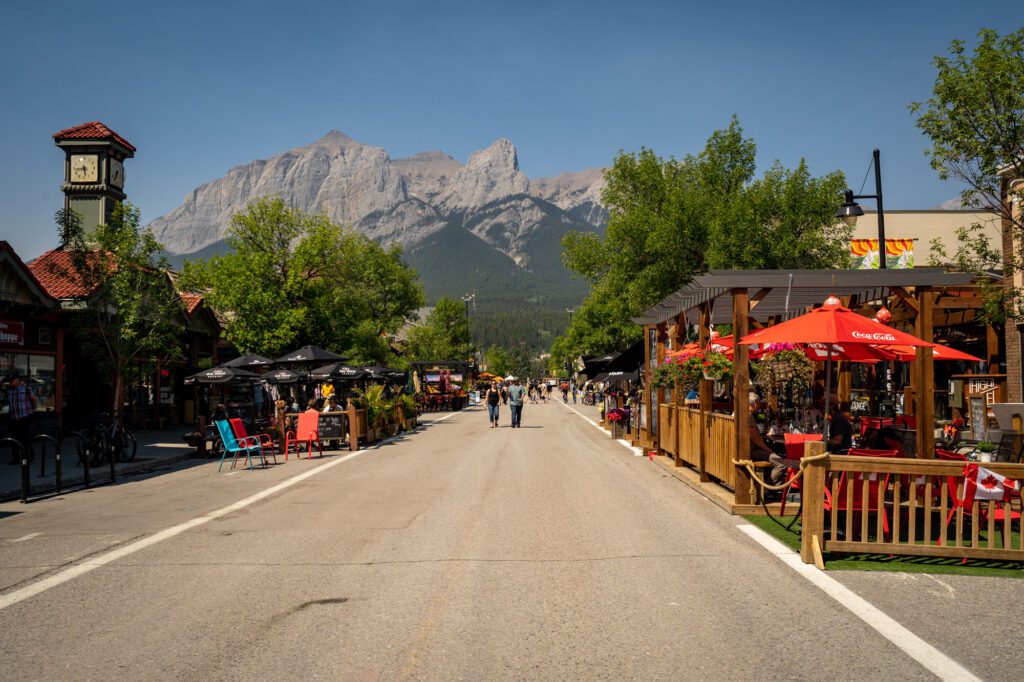
Next time we’re in the Canadian Rockies, you’ll find us staying in Canmore rather than Banff.
We prefer the vibe of Canmore, where it’s a mix of people who live there and tourists, there is a better selection of places to eat and drink, and you get more bang for your buck in terms of lodging.
Canmore is outside of the eastern boundaries of Banff National Park, which means that it does add 15-20 minutes of driving to go anywhere in the park.
That being said, Canmore has plenty of outdoor recreation going on in its own right, and is actually closer to some of the less trafficked hiking trails in Kananaskis.
Basically, we think Canmore is cooler and offers a better value than Banff, which is why we’d highly recommend it.
The biggest downside is the extra driving, which includes passing through the park entrance where you can sometimes get big lines (though there’s a pass-through line if you already have purchased your entry or have a Discovery Pass).
Pros and Cons of Staying in Canmore
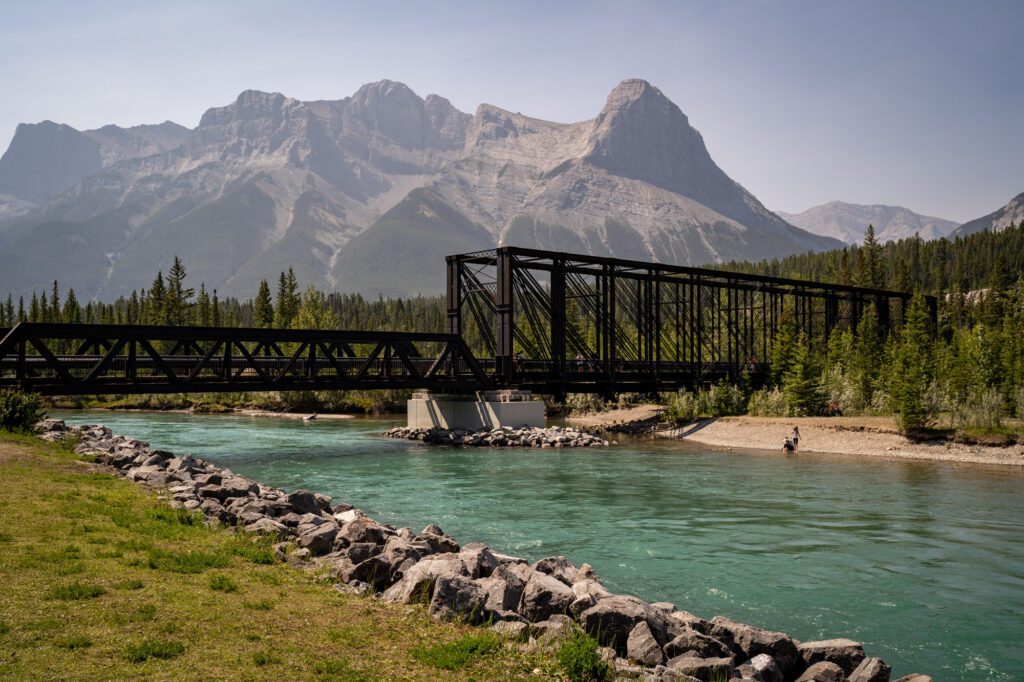
Pros of Staying in Canmore:
- Great food and drink options. From coffee shops to microbreweries to places to eat, Canmore is head and shoulders above Banff (and definitely Lake Louise) in this category. If you want to hit the trail by day and stuff your face by night, we’d opt for Canmore over Banff.
- More affordable. Now, context is important – you’re still in the Canadian Rockies, so prices are relatively high no matter what – but as we were searching for our latest trip, we noticed that prices were notably less expensive in Canmore, and you’re generally getting more bang for your buck.
- More updated accommodations. For whatever reason – maybe because Canmore is a more recent addition to the tourist map than Banff – the accommodations in Canmore don’t suffer the same “needs some TLC” issue as many places in Banff. In fact, there are a bunch of very modern options (subway tile bathrooms are a huge indicator).
Cons of Staying in Canmore:
- It’s further out. It’s east of the town of Banff, which means it’s further away from just about everything by about 15-20 minutes.
- Public transit is hit or miss. While there is public transit from Canmore to Banff via ROAM Transit, you do have to make a connection to use public transportation to get from Canmore to places like Lake Louise, Moraine Lake, or Sunshine Meadows.
- Lineups at the park entrance. We only saw this on a Saturday morning entering the park, but there can sometimes be long lineups at the park entrances. However, if you already have a Parks Canada pass, there are two lanes to bypass the lines.
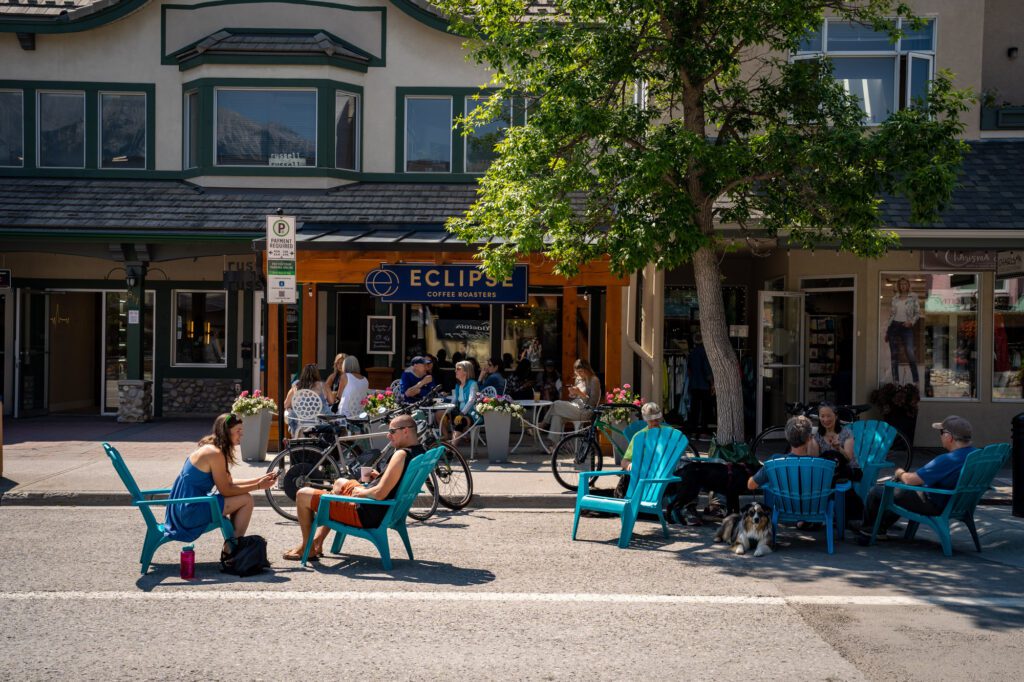
The Best Places to Stay in Canmore
Here are a few places to stay in Canmore that caught our eye.
The Malcolm Hotel: Canmore’s Coolest Luxury Hotel
The Malcolm Hotel is almost certainly the most beautiful hotel in Canmore, which is not terribly surprising because it is also one of the newest. It’s along Spring Creek Drive, which puts you right along the creek, and a 10 minute walk or so into downtown Canmore.
Rooms are your typical hotel configurations, with options ranging from two queen beds to one king bed. Some rooms have mountain views, but you’ll have to pay a little extra for it.
The crown jewel of the hotel is the rooftop swimming pool, which has jaw-dropping views of the surrounding mountains.
If you’re not into swimming (or it’s winter), there are also firepits up there where you can enjoy the views accompanied by the warm glow of a (fake) fire.
There’s an onsite restaurant, an onsite coffee shop, and a fun game room with foosball, a giant Scrabble wall, and a pool table (among other things).
Pet friendly? Yes, with a $50 pet fee.
What’s the parking situation? Free parking in the underground lot.
Lamphouse Hotel by Basecamp: A Mid Range Hotel in Downtown Canmore
Hey, look, another Basecamp Hotel! If you missed our love letter above, we really enjoyed our stay at Basecamp in Revelstoke, and wish we would have stayed at one of their numerous locations in Canmore instead of where we ended up. Oh well, live and learn!
The Lamphouse Hotel is on the eastern end of the main stretch in Canmore, which puts you a 3-5 minute walk from our favorite places to eat, drink, and shop in town.
The layout is motel-style, but the rooms lean more boutique hotel than your typical motel. They also have a nice shared hot tub, which is a good place to soak after a long day on the trail.
The rooms here are split between hotel-style rooms, with either one king or two queen beds, and suites with a seating area and a little more space. Decor is modern, with subway tile in the bathroom and mid-century modern (ish) furniture.
Pet friendly? Yes, but only some rooms are pet-friendly (max two pets per room).
What’s the parking situation? Free parking (for one vehicle) in the onsite lot.
Stoneridge Mountain Resort: Beautiful Suites with Full Kitchens (Great for Families)
Stoneridge Mountain Resort may be on Railway Avenue, a main thoroughfare through town where most of the hotels in Canmore are located, but the luxury resort feels like a little oasis in the mountains.
The key difference between Stonridge and, say, the Malcolm Hotel, is that the rooms here are suites, which means they offer more space and full kitchens.
We’re personally more into suite-style hotels, which give you the blend of service of a hotel and extra space / amenities of a vacation rental.
The suites here are delightfully modern and design-forward, with beautiful kitchens, air conditioning, and in-unit laundry.
Each unit also has a private patio or balcony and a private BBQ, which is a nice touch. They come in various configurations, but are basically divided between one, two, and three bedroom suites.
The amenities here match the upscale vibe of the rooms, with outdoor heated pools (available year round), a 24/7 fitness center, and heated underground parking (which is only really relevant in the winter).
Pet friendly? No pets allowed.
What’s the parking situation? Free parking in the onsite lot.
Ambleside Lodge Bed & Breakfast: A More Intimate B&B Experience
Compared to the grandeur and largesse of the previous two hotels we’ve mentioned, the Ambleside Lodge offers a more intimate, rustic bed and breakfast experience despite being roughly equidistant from all the action in Canmore.
The location is nice and quiet, just over the Bow River from the downtown core of Canmore, where you’ll find the best places to eat, drink, and shop along with the picturesque riverside trail (walk it up to Engine Bridge!).
It’s also family owned and operated, which we always find to be the best experience and service.
There are only three guest rooms here, so you’ll need to book ASAP if you want to snag one of them. Each room is thoughtfully designed with warm wood tones, private bathrooms, and includes breakfast in the morning.
There’s a big living room too, with vaulted ceilings, tons of natural light, and a cozy fireplace.
One thing to know here: no kids under 12 allowed, and there’s a two person maximum per room, which means this probably isn’t a great option for families.
Pet friendly? No pets allowed.
What’s the parking situation? Free parking in the onsite lot.
Canmore Downtown Hostel: The Best Place to Stay on a Budget
If you’re wanting a social atmosphere and a place to stay that won’t break the bank, Canmore Downtown Hostel is a good option.
This place is very highly rated, and browsing through their pictures will show you relatively new facilities with a big shared kitchen, a dining room / living room with mountain views, and clean shared bathrooms.
It is worth noting that, despite the name, this isn’t really in downtown Canmore. It’s several blocks off of the main drag, but it’s definitely within walking distance of the heart of town and all the good places to eat and drink.
As you might expect from a hostel, they have a mix of dorm rooms (maximum of eight beds, some rooms with ensuite bathrooms) and private rooms. One of the dorm rooms is women only.
Private rooms come in a couple of different configurations, including layouts with bunk beds or two single beds.
Pet friendly? No pets allowed.
What’s the parking situation? Free parking in the onsite lot.
Bow Valley Provincial Park: Best Camping Options near Canmore
If you want to camp, Bow Valley Provincial Park is BY FAR the best option. Though, it is also the most popular, which means you’ll need to plan in advance to snag a site here.
There are multiple campgrounds within the park, and two of the nicest in terms of amenities and location are going to be Bow River Campground (66 sites) and Three Sisters Campground (36 sites).
The downside to these campgrounds is that they’re all essentially right on the Trans Canada Highway, which means they can be loud.
Lake Louise: The Best Place to Stay to Access Lake Louise and Moraine Lake
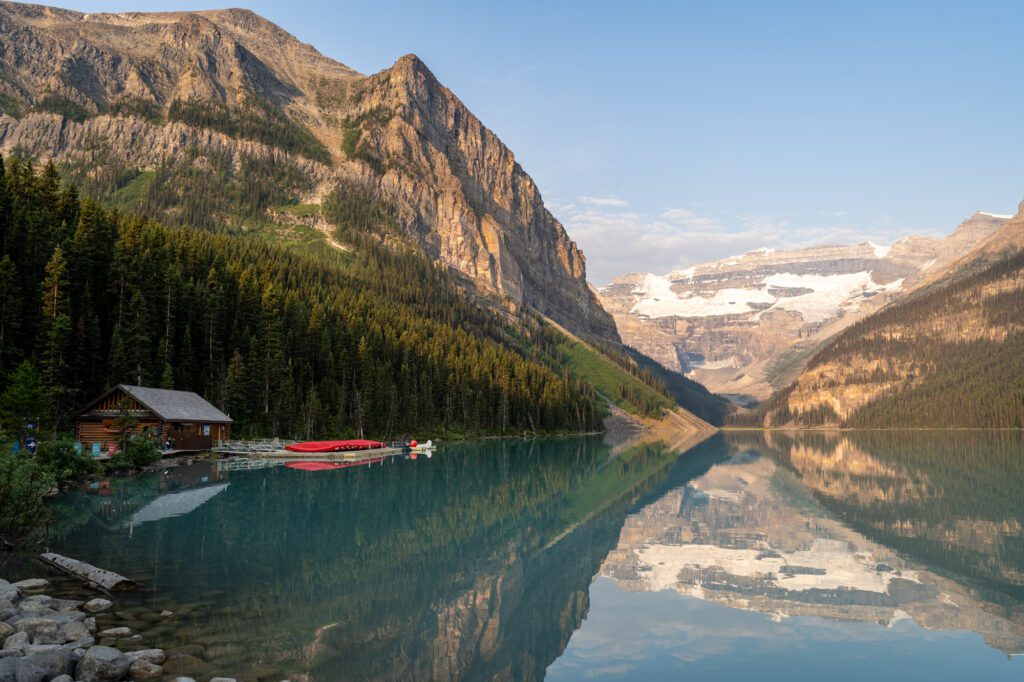
As we’ve already covered, we would definitely recommend spending a night or two (ideally two to set you up for visiting both lakes early in the morning) out near Lake Louise, because after doing the whole drive back and forth thing ourselves, it’s a lot of driving from Banff and Canmore.
The biggest problem with that plan is that there just really aren’t that many good places to stay near Lake Louise Village, which sits at the base of the road that leads up to both lakes.
Which means that the places to stay that do exist are going to be competitive and expensive.
Still, it’s not like staying in Banff is going to be a cheap date anyway, and we think it’s worth the extra moving around to be able to access one of the most beautiful lakes in the world at your leisure (we definitely recommend seeing it both early in the morning and late in the evening).
Another bonus of staying here is that it’s a convenient location for a day trip up the Icefields Parkway or over to Yoho National Park, which is just 15 minutes west of Lake Louise.
Both are well worth a trip, and you’ll find both on our SUPER detailed Canadian Rockies itinerary.
Pros and Cons of Staying near Lake Louise
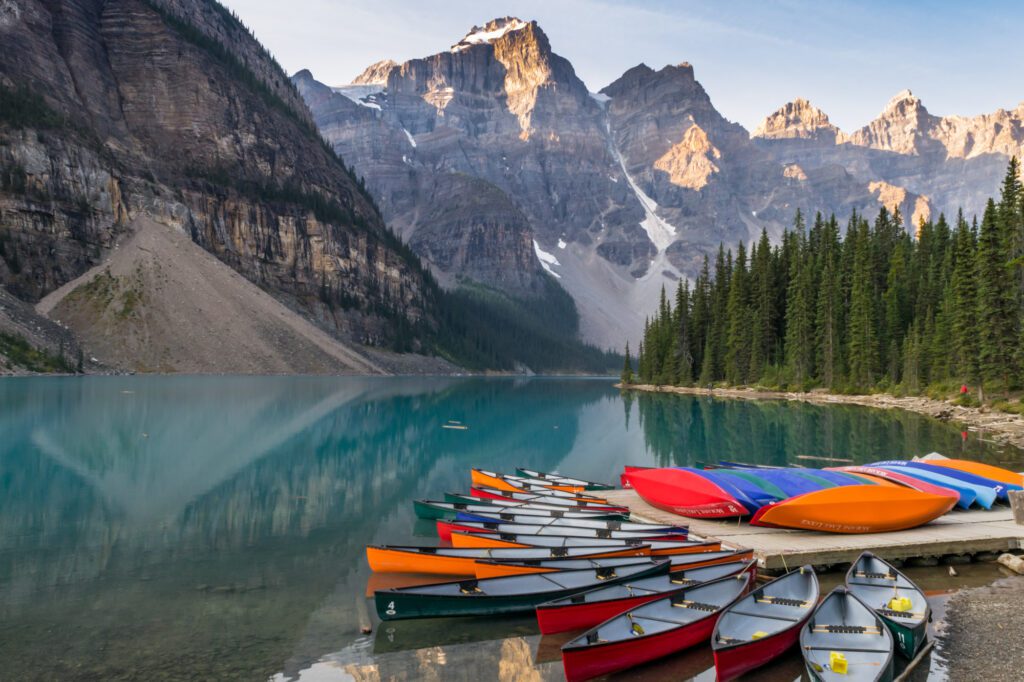
Pros of Staying near Lake Louise:
- Easy access to Lake Louise. You’ll save 45-60 minutes of driving to and from Lake Louise twice (once for Lake Louise, once for Moraine Lake). Plus, you’ll be able to go at multiple times of the day (early in the morning and around sunset are incredible).
- Closer to Yoho and the Icefields Parkway. There are some really great hikes and places to go in both Yoho and on the southern end of the Icefields Parkway between Banff and Jasper, and Lake Louise is actually a good base for them.
Cons of Staying near Lake Louise:
- Far from most things in Banff National Park. While you’re saving time driving between Banff and Lake Louise, the reverse is also true. This is why we recommend splitting your time up between Banff and Lake Louise so that you get the best of both worlds (without all the driving).
- Very limited places to stay, and very competitive. There are very few places to stay near Lake Louise, and the ones that do exist are very competitive (including the campground). BOOK EARLY!
- Very Pricey. As you might have guessed based on the last bullet, it’s also very pricey. However, there are a couple of good budget options – namely the HI and the campground – but, again, you’ll want to book them ASAP.
The Best Places to Stay near Lake Louise
As we’ve already covered, there really aren’t that many places to stay here, so we’re going to include a few places where reviews are a little lower than we normally would simply because they’re…the only game in town.
Just so you know, we’re not going to include the Fairmont Chateau Lake Louise on our list, simply because we don’t think it’s accessible to most people, and we wouldn’t really even consider paying $600-$900 a night to stay there ourselves.
A better option would be to stay elsewhere and stop in for a meal or tea to check it out.
Paradise Lodge and Bungalows: A Great Option (Where We Stayed)
We can’t stress enough that, based on our own experience staying there, Paradise Lodge & Bungalows is the best place to stay near Lake Louise for 99% of people.
You could argue that it’s the Fairmont Chateau, but who can afford that? You could also argue for the Lake Louise Campground, which is lovely, but not everyone is 1) able to camp, especially when flying in and 2) able to get reservations there.
Spoiler alert: you’ll find both of those below.
We would have totally stayed here on our latest trip, but they don’t allow pets and we had Lupine with us.
The location is pretty superb. It’s right on Lake Louise road, about a five minute drive to the main lot at the lake.
It’s only a mile from the lodge to the lake, so you could also walk there and skip the whole parking situation altogether (though it adds two miles roundtrip, which might be a dealbreaker if you’re doing a long hike like the Plain of Six Glaciers or Big Beehive).
In terms of room types, there are basically two options here; lodge rooms and standalone bungalows.
We stayed in a bungalow, and it was great – rustic, charming, but very comfortable. Some – not all – bungalows have full kitchens (ours did not).
They basically come in two layouts: a studio without a kitchen, and a studio with a kitchen. All of the cabins have a cozy gas fireplace.
Lodge rooms are more like a hotel room, and they come in three different configurations: a two bedroom suite with NO kitchen, a one bedroom suite WITH a kitchen and a pullout couch, and a one bedroom fancy suite (honeymoon suite) with a soaking tub and kitchen.
The latter two room types also have a balcony.
Pet friendly? No pets allowed.
What’s the parking situation? Free parking in the onsite lot.
Baker Creek by Basecamp: Nice Option Along the Bow Valley Parkway
Another Basecamp location! If you missed it above, we stayed at Base Camp in Revelstoke and enjoyed it so much that we wish we’d stayed at another one of their locations around Banff and Canmore for that leg of our trip. Next time!
While Baker Creek by Basecamp is a little further out than many of the options above (it’s along the Bow Valley Parkway, about 20 minutes from the lake’s parking lot), the cozy cabins and suites here would make a nice home base, especially considering the shuttles that stop here and whisk you away to Louise and Moraine Lakes.
There are two basic room types here; cabins and lodge suites.
The suites skew more modern, and they have a few different layouts (all with one bed and kitchenettes without a stove) including some with a jacuzzi tub.
The cabins are where it’s at, we think. They have one or two bedroom options, all with cozy fireplaces, kitchenettes with microwaves and mini fridges, and fairly spacious living areas.
Some also have jacuzzi tubs in the middle of the studio-style layout, which is… a choice.
The point is that, whether you’re traveling with your family and need some extra space, or you’re looking for a romantic getaway with your partner, they’ve got options.
One underrated benefit of staying here: there’s a Moraine Lake (and Lake Louise) shuttle that picks up and drops off at the resort during the summer months, which means you don’t have to deal with parking at the lakes, or with lines for the Parks Canada Shuttle.
Full disclosure – it is more expensive than the Parks Canada shuttles, but it’s also more convenient and means you don’t have to drive at all.
Pet friendly? Yes, with a $40 a night pet fee and advance notice.
What’s the parking situation? Free parking in the onsite lot.
Castle Mountain Chalets: A Good Option for Both Banff and Lake Louise
The Castle Mountain Chalets, which are right off of the Trans-Canada Highway at Castle Mountain Junction, were a relatively late discovery for us as we were putting together this guide.
We ultimately decided we had to include them because they’re roughly equidistant to Banff and Lake Louise (slightly closer to Lake Louise, about 20 minutes away), which means that they might actually be a good home base for your entire trip.
Similar to a lot of the other resorts in the area, they have a mix of rooms split between chalets and suites, but the mix leans much more towards chalets here.
There are one and two bedroom options, along with chalets that have an open plan (studio) layout, which means they have options for a variety of different group sizes.
As far as I can tell, all of the room options here have a full kitchen including stoves and ovens, and are fairly spacious with plenty of room to spread out.
In terms of amenities, you’ve got free parking, a shared barbecue area, firepits, shared laundry, and snowshoe or mountain bike rentals.
Pet friendly? Yes (only in chalets, not in suites), with a $25 a night pet fee (dogs only, two dogs max).
What’s the parking situation? Free parking for one vehicle in front of chalets, others in an overflow lot.
HI Lake Louise Alpine Centre: An Affordable Hostel in Lake Louise Village
If you’re looking for the most affordable place to stay (that’s not camping), this is easily it.
The HI Lake Louise Alpine Centre is a hostel down in Lake Louise Village, which means it’s not walkable to the lake, but it is significantly closer than staying in Banff or Canmore. Plan on a 10-15 minute drive to the lake from here.
We don’t have much to say about this place, other than the fact that it’s a bed, in a hostel, in a place close to one of the most popular tourist attractions in Canada.
Is it modern? Not really.
Are the facilities top of the line? Not really.
Is it a good place to spend a few nights to explore the two lakes for relatively cheap? Probably.
They have a mix of bunk rooms and private rooms, some of which have beds for 4-5 people if you’re traveling with a group, and some of which have ensuite bathrooms (rather than shared). There’s a communal kitchen and shared living spaces.
Pet friendly? No pets allowed.
What’s the parking situation? Free parking in the onsite lot.
Lake Louise Campground: Best Campground near Lake Louise
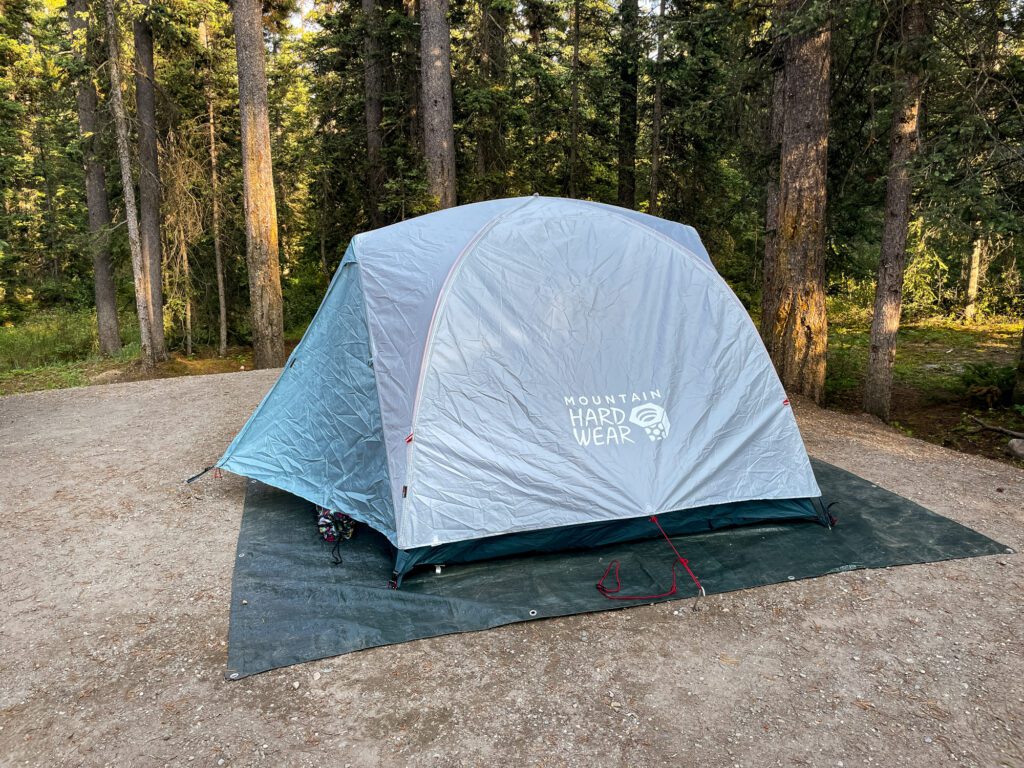
If you’re able to camp (some people aren’t able/willing to bring their camping gear on the plane), this is probably the absolute best option in terms of value and location.
However, it’s a little bit of a pain to get a site here, as you have to be on it and ready to book the day that reservations open to the public in the spring (more information here).
There are two campgrounds here – a soft-sided campground that is for tents and is surrounded by bear wire to prevent unwanted wildlife encounters, and a hard-sided campground for RVs, trailers, and vans.
We snagged a site at the soft-sided campground and were STOKED at having a 5-10 minute drive to Lake Louise.
However, upon setting up our tent, making dinner, and hanging around camp until dark, we learned that Lupine (our dog) is NOT a fan of being enclosed in a tent. Whoops.
There are more than 200 tent sites (and another 200 or so RV sites) here, so it’s not going to be much of a secluded wilderness experience.
But the facilities are really nice, including showers, and the location could not be better.
